Osteoarthritis, Physical Therapy
8 Ways Physical Therapy Helps Seniors Manage Osteoarthritis Pain and Improve Mobility
Is Osteoarthritis Limiting Your Mobility? Here’s How Physical Therapy Can Help
Osteoarthritis (OA) is a common condition that affects millions of seniors worldwide. Have you ever experienced stiffness in your knees after sitting for a while or pain in your hips when walking?
If so, you may be dealing with osteoarthritis, the most common type of arthritis that affects over 32.5 million adults in the U.S., according to the CDC.
Osteoarthritis occurs when the cartilage that cushions your joints begins to wear down, causing pain, stiffness, and swelling.
While OA is a chronic condition, the good news is that physical therapy can help you manage these symptoms, improve joint function, and keep you moving. In fact, with the right treatment plan, you can regain your independence and continue doing the activities you love.
Let’s explore how osteoarthritis is diagnosed and the 8 specific ways physical therapy can benefit seniors with OA.

How Is Osteoarthritis Diagnosed?
If you suspect you have osteoarthritis, your healthcare provider will take the following steps to confirm the diagnosis:
- Review Your Medical History: Your doctor will ask about your symptoms, when they started, and if certain activities make the pain worse. They’ll also inquire about any family history of arthritis since genetics can play a role.
- Conduct a Physical Exam: A thorough examination of your joints will help assess your range of motion, strength, and any visible signs of swelling or tenderness. Your doctor may move your joints to detect crepitus (a grating sound) or fluid buildup.
- Order Imaging Tests: X-rays are typically used to spot signs of osteoarthritis, such as joint space narrowing, bone spurs, or cartilage loss. An MRI may be ordered for a more detailed look at your joints and surrounding tissues if necessary.
- Perform Lab Tests: Blood tests aren’t used to diagnose OA directly, but they can help rule out other conditions, like rheumatoid arthritis. Sometimes, your doctor may perform a joint fluid analysis to check for infections or other forms of arthritis that can mimic OA symptoms.
Once diagnosed, physical therapy is one of the most effective treatments for managing osteoarthritis.
Read More: Occupational Therapy for Older Adults: Enhancing Quality of Life
Below are 8 unique ways it can help seniors stay active and reduce pain.
1. Correct Your Walking Pattern to Reduce Joint Strain
Many people don’t realize that changes in their walking pattern can increase the strain on their joints. Over time, this can make osteoarthritis symptoms worse.
Physical therapists can evaluate your gait and teach you how to walk in a way that reduces pressure on your knees, hips, and ankles. These small adjustments can make a big difference in your comfort and help prevent additional joint damage.
2. Improve Balance and Prevent Falls
Seniors with osteoarthritis are at a higher risk of falling due to weak muscles and joint instability. According to the National Osteoporosis Foundation, one in four adults over 65 experiences a fall each year.
Physical therapy helps strengthen the muscles around your joints, improving balance and coordination. This not only reduces the likelihood of falls but also boosts your confidence in moving around safely.
3. Strengthen the Muscles That Support Your Joints
Weak muscles can put additional stress on your joints, making osteoarthritis pain worse. Physical therapists can design a customized exercise plan to build muscle strength around the affected joints.
For example, stronger quadriceps can relieve pressure on the knees, and stronger hip muscles can support the lower body. These exercises are tailored to your specific needs, ensuring that you gain strength without overstressing your joints.
4. Manual Therapy to Reduce Swelling and Stiffness
Hands-on therapy, or manual therapy, is an effective way to reduce joint swelling and stiffness. Physical therapists use gentle techniques like joint mobilization to improve blood flow, reduce inflammation, and ease pain.
This is especially helpful for small joints, such as those in the hands or feet, where swelling can significantly limit movement. Regular manual therapy sessions can make a noticeable difference in how your joints feel day to day.
5. Tailored Stretching Routines to Improve Flexibility
Osteoarthritis can make your joints feel stiff, especially in the morning or after long periods of inactivity. Physical therapists create personalized stretching programs that help loosen tight muscles and increase flexibility in the affected joints.
These stretches are gentle and safe, targeting your problem areas without causing additional discomfort. Improved flexibility means you can move more easily and with less pain during daily activities.
6. Delay or Avoid Surgery With Strengthening Exercises
Many people fear that surgery is the only solution for severe osteoarthritis, but physical therapy can often delay or even prevent the need for joint replacement.
A 2019 study published in Osteoarthritis and Cartilage found that 70% of patients with knee OA were able to avoid surgery by participating in physical therapy.
Strengthening the muscles around the joints, reducing inflammation, and improving overall mobility can help you manage pain and maintain function, sometimes eliminating the need for surgery.
7. Regain Mobility and Range of Motion
One of the most frustrating symptoms of osteoarthritis is the loss of mobility and range of motion. Over time, joints may feel locked, and movements become more difficult.
Physical therapy can restore joint flexibility through guided exercises that focus on regaining motion. These exercises can be adjusted to your comfort level and are designed to make daily tasks—like climbing stairs, bending down, or reaching overhead—much easier.
8. Learn Joint Protection Techniques for Everyday Activities
Physical therapists can also teach you strategies for protecting your joints during daily activities. This might include learning how to lift objects safely, improving your posture while sitting, or using assistive devices like a cane or walker.
By modifying the way you move and perform tasks, you can reduce strain on your joints and prevent further damage. These joint protection techniques make a big difference in maintaining your independence and reducing pain over the long term.

Embrace a More Active, Pain-Free Life With Osteoarthritis Physical Therapy
Osteoarthritis doesn’t have to slow you down. With a personalized physical therapy plan, you can manage your symptoms, reduce pain, and regain your mobility.
Whether you’re looking to improve your balance, strengthen your muscles, or avoid surgery, physical therapy offers practical solutions that can help you stay active and independent.
If osteoarthritis is affecting your quality of life, don’t wait to take action. Speak with your healthcare provider or a physical therapist to create a treatment plan that works for you.
The path to better joint health and pain relief starts with the right support—and the sooner you begin, the better you’ll feel.
If you're ready to manage your osteoarthritis pain and improve your mobility from the comfort of your home, contact Denver Physical Therapy at Home today for osteoarthritis physical therapy.
Our expert therapists will work with you to create a personalized plan tailored to your needs, helping you stay active and independent without the need to travel.

References
Centers for Disease Control and Prevention (CDC). (2020). Osteoarthritis (OA). https://www.cdc.gov/arthritis/osteoarthritis/
National Osteoporosis Foundation (NOF). (2020). Falls and Osteoporosis. https://www.bonehealthandosteoporosis.org/conditions-and-medicines-that-can-cause-falls/
Effects of exercise therapy on joint instability in patients with osteoarthritis of the knee: A systematic review. Osteoarthritis and Cartilage Open, 2(4), 100114. https://doi.org/10.1016/j.ocarto.2020.100114
National Institute of Arthritis and Musculoskeletal and Skin Diseases. (2023, September). Osteoarthritis. National Institute of Arthritis and Musculoskeletal and Skin Diseases. https://www.niams.nih.gov/health-topics/osteoarthritis

